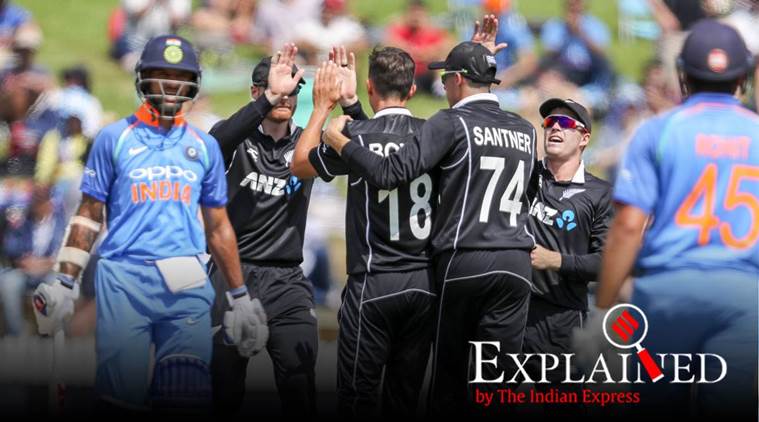Explained: How India succumbed to swing against New Zealand
The Seddon Park pitch’s extra bounce added to the Indian batsmen’s problems when facing Boult.
 New Zealand celebrates the wicket of India’s Shikhar Dhawan, left, during their fourth one day international cricket match at Seddon Park in Hamilton, New Zealand. (AP Photo/John Cowpland)
New Zealand celebrates the wicket of India’s Shikhar Dhawan, left, during their fourth one day international cricket match at Seddon Park in Hamilton, New Zealand. (AP Photo/John Cowpland)
It was the left-arm pacer Trent Boult’s late in-swinging full-length balls that were chiefly responsible for India folding up for 92 and eventually losing in the 4th ODI at Hamilton.
Rohit Sharma, Shubhman Gill and Ambati Rayudu all fell to deliveries that are generally believed to be the left-handed swing bowlers’ sharpest weapon. Remember those Wasim Akram missiles to right-handers that he let go from the over the wicket, the ones that seemed to be heading towards the slips, but would suddenly dart in towards the middle stump? Invariably they would crush the toe of the batsmen, or hit the stumps.
Boult, after a rather insipid show in the first three ODIs played, found that Akram-swing at Seddon Park, a venue close to the Waikato River. With the temperature at Hamilton close to 30 degrees, sun shining brightly and humidity pretty high, the conditions were conducive for the white ball to move around in the air.
Modern science has proved that ground heat creates turbulence in the air which aids swing. And when an express speedster like Boult gets the ball to curve late, the batsmen always struggle. He also stuck to that elusive good length that makes the ball to pitch close to the pads, also called batsmen’s blind spot.
 New Zealand’s Trent Boult, second from right, is congratulated on taking a wicket during their one day international cricket match at Seddon Park in Hamilton, New Zealand. (AP Photo/John Cowpland)
New Zealand’s Trent Boult, second from right, is congratulated on taking a wicket during their one day international cricket match at Seddon Park in Hamilton, New Zealand. (AP Photo/John Cowpland)
The Seddon Park pitch’s extra bounce added to the Indian batsmen’s problems when facing Boult. First, Sharma was cramped for space when a Boult in-swinger came in sharply at him. The extra bounce resulted in the ball hitting the bat higher, and ballooning back to Boult. Gill also made the same mistake to a similar ball.
Rayudu, meanwhile, didn’t read the swing at all. He couldn’t get his bat down quickly, and was out lbw. The Boult spell was a reminder that the best of batting units can struggle when the sultans of swing get it right.
- 01
- 02
- 03
- 04
- 05







































